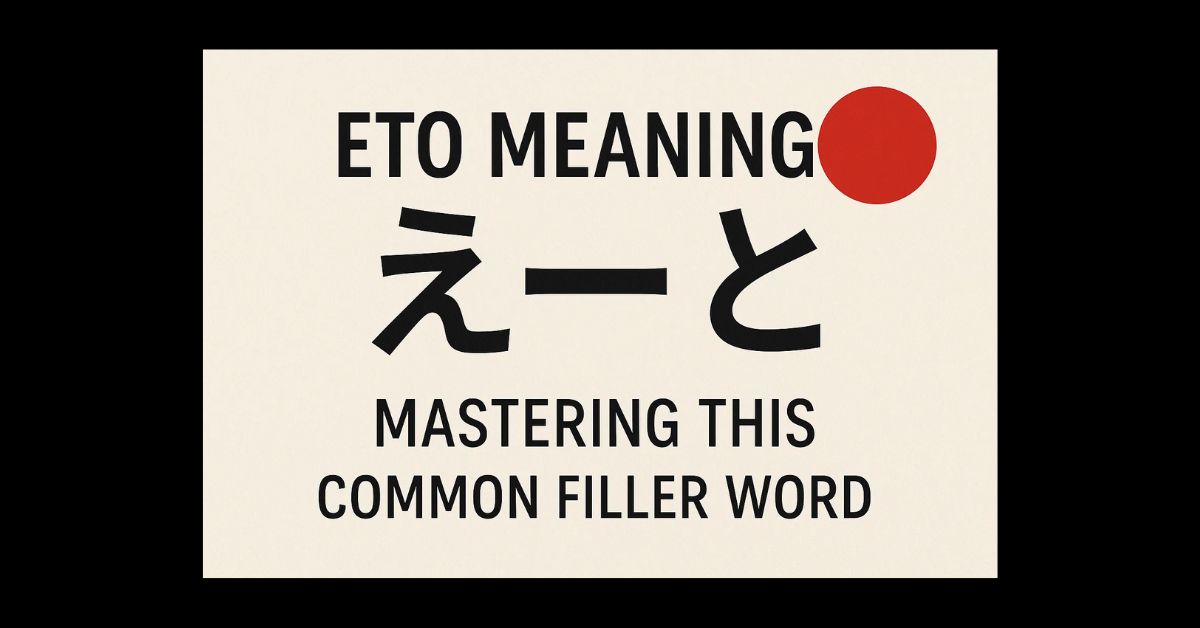Have you ever heard someone speak “eto” in Japanese and not know what it means? The eto meaning Japanese students usually request about is actually really straight headfirst; it’s just a usual way of pausing when one is thinking. Like “um” or “uh” in English, eto Japanese publics use it when they need a moment to think. So, what is eto Japanese for?
It’s a normal filler word in Japanese that’s commonly used in normal chat. You can hear it in regular chats, anime seconds, or when a person doesn’t know how to respond. Knowing Japanese filler words like “eto” makes your voice sound closer to that of a native speaker.
What Does Eto Mean in Japanese?
The eto meaning Japanese learners should know is that it’s a simple sound people make when they pause. It’s like saying “um” or “uh” while thinking. You’ll often hear eto Japanese speakers use it in casual talk or when they’re shy.
It’s a polite style of asking yourself for a second before speaking. When you’re having a chat, mostly in anime or real life, it shows that you’re taking your time to think about what to say.
Quick answer : Eto in Japanese translates to “um” or “uh” and is utilized where one pauses to think while speaking.
How to Pronounce Eto Correctly
Speaking “eto” in Japanese is simple once you learn how to break it down. The sound is smooth and gentle, similar to how you would speak “um” in English when you’re thinking.
🎧 Sound Breakdown
- え (e):
Sounds like the “e” in “bet” — fast and light. - と (to):
Sounds like “toe” in English — short and clear. - Together:
“Eh-toe” — say it slowly at first, then more naturally with practice.
Most people asking what does eto mean in Japanese are equally stunned on how to speak the word. Being able to master this little sound gives you more coolness when speaking eto Japanese indeed.
When to Use Eto in Japanese Conversations
The meaning of “eto” in Japanese can change a little depending on how it’s used. Let’s look at some of the most common states where it shows up.
1. While Thinking of What to Say
えーと、明日の予定は…
Ēto, ashita no yotei wa…
“Umm… about tomorrow’s plans…”
2. When Trying to Remember Something
えーと、彼の名前は…田中さんだったかな。
Ēto, kare no namae wa… Tanaka-san datta kana.
“Umm… his name was… I think it was Mr. Tanaka.”
3. When Hesitating Before Answering a Difficult Question
「好きな食べ物は何ですか?」 「えーと、そうですね…」
“Sukina tabemono wa nan desu ka?” “Ēto, sō desu ne…”
“What’s your pet food?” “Umm… let me think…”
Eto vs. Other Japanese Filler Words
If you really want to get the hang of the eto meaning in Japanese, it helps to see how it loads up against other common Japanese filler words.
| Filler Word | Meaning | Primary Usage |
| えと (eto) | Um, uh | When thinking or hesitating |
| あの (ano) | Um, well | Getting care or hesitation |
| まあ (maa) | Well | Stating indifference |
| なんか (nanka) | Like, sort of | Stating doubt |
| そうですね (sō desu ne) | Let me see, well | Seeing a reply |
Beings tend to cloud “ano” and “eto”, but they have a slight change between them. “Ano” is usually called out to catch someone’s attention before you actually speak, whereas eto in Japanese is used when you have now begun and need a second to collect your views.
Want to explore Japan’s culture?
If you’re studying the eto meaning which Japanese speakers employ, it’s a superb break to learn more of Japan’s culture. Phrases such as eto Japanese show how beings communicate civilly and kindly within everyday life. So as you inquire what does eto mean in Japanese, you’re seeing the very heart of Japanese letter and nation.
Tips for Using Eto Naturally
After learning the eto meaning used by Japanese speakers on a daily basis, the next thing to do is applying it well. These are the tips that will make you sound more natural when you say eto Japanese in everyday chats.
🔹 Don’t Say It Too Much:
Overdoing filler words like eto in Japanese can make you sound shy or tense.
🔹 Stretch It Out Naturally:
Saying “えーと (eeeto)” with a soft tone sounds more natural than the short style.
🔹 Mix It with Other Fillers:
Japanese speakers often pair eto with words like ano or sō desu ne to buy time.
🔹 Use It Based on the Situation:
In very correct settings, it’s better to avoid filler words like eto altogether.
🔸 Keep It Balanced:
Using eto Japanese here and there sounds usual, but too much can break the flow.
🔸 Match the Vibe:
Think about where you’re speaking; casual chats are perfect for eto, but polite meetings aren’t.
Once you know what eto mean in Japanese, using it the correct way is a big difference. They are little secrets to speaking flatter and more naturally in any Japanese chat.
Common Expressions Using Eto
Here are some common sayings that you’ll likely hear or use eto in everyday Japanese chats.
1. えーと、どうしようかな。
Ēto, dō shiyō kana.
“Umm… what should I do?”
2. えーとね、説明が難しいんだけど…
Ēto ne, setsumei ga muzukashiin dakedo…
“Well, it’s kind of hard to explain…”
3. えーと、確かそれは先週だったと思います。
Ēto, tashika sore wa senshū datta to omoimasu.
“Umm… I think that was last week.”
4. えーと、それはちょっと分かりません。
Ēto, sore wa chotto wakarimasen.
“Umm… I’m not really sure about that.”
How Eto Connect to Japanese Culture
The eto meaning Japanese students learn isn’t merely about hesitating, it’s a sign of how beings in Japan converse kindly. In Japanese culture, silence or hesitation shows care. That’s why eto Japanese use the term to purchase some time before replying. It’s a signal of respect by thinking ahead of speaking.
It’s not just a noise, it’s polite speech. Speaking Japanese filler words such as eto makes your speech sound more natural and less strained. That is why most native Japanese speakers make use of it in everyday speech, mostly when not quite sure or careful with words.
Expanding Your Japanese Vocabulary Beyond Eto
Since you now know the eto meaning Japanese use, it’s time to swell your language even further. Seeing other words makes you sound even more natural in many situations. Eto Japanese is only one of many handy filler words in Japanese.
🔹 Learn Other Common Filler Words
Words like ano, maa, and nanka also help you pause and think indeed.
🔹 Study Everyday Phrases
Build facilities with common languages, not just single words.
🔹 Watch Japanese Shows or Anime
Listen for how native Japanese speakers use eto and other casual sayings in real speech.
🔹 Practice With Real Conversations
Try using eto in Japanese with friends or tutors when you pause or pause.
🔹 Explore Polite and Formal Expressions
Balance casual words like eto with respectful sayings for changed states.
So, next time someone asks what does eto mean in Japanese, you’ll know and you’ll also have plenty more words to use. Growing your language is a big step toward sounding like a natural Japanese speaker.
Q&A About Eto Meaning in Japanese
❓ Is eto formal or informal in Japanese?
Eto in Japanese is neutral, often used in casual or semi-formal speech, but should be stopped in very formal states.
❓ How do you write eto in Japanese?
The eto meaning Japanese learners should know is written as えと in hiragana. The busy style is written as えーと.
❓ Is it rude to use eto too much?
No, it’s not rude. But overusing eto Japanese can make you sound shy or improvised in a chat.
❓ What’s the difference between eto and ano?
Eto shows thinking while speaking. Ano is used to getting care before speaking.
❓ Can I use eto in written Japanese?
Eto Japanese is mostly spoken. In writing, it’s used in manga or dialogs to show natural, casual speech patterns.
❓ What is Eto in Japanese culture?
The eto meaning Japanese speakers use reveals care. It shows respect by pausing to think before answering or speaking.
❓ What is the meaning of the name Eto?
As a name, Eto (江藤 or 衛藤) can mean “bay wisteria” or “caring wisteria” subject on the kanji used.
Conclusion
Buying the eto meaning used by Japanese speakers is a square forward and strong move toward being more normal-sounding during speech. Language learners who know what does eto mean in Japanese know when and how to politely pause. Although eto Japanese is mostly a spoken filler, it is socially significant because it shows care and respectful statement.
Mastering how to use “eto” well, in addition to other Japanese filler words, enhances fluency and allows you to join naturally like a native. As your language surges, listen to authentic chats, practice on a regular basis, and enjoy the route of learning natural, everyday Japanese surely and easily.

